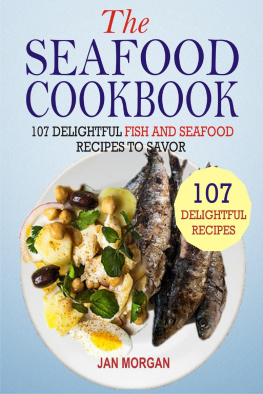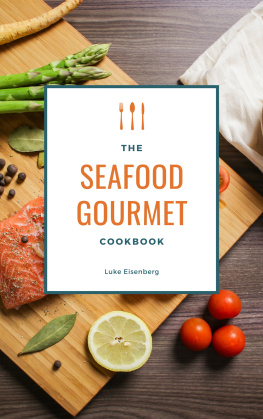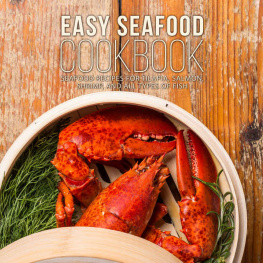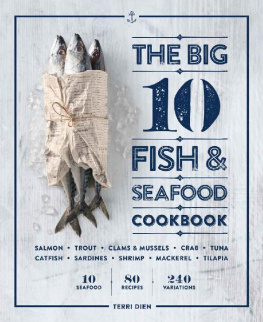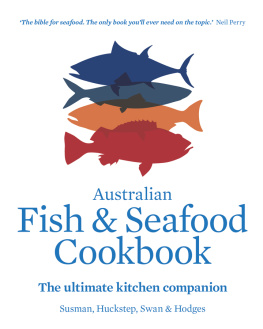PJ Stoops - Texas Seafood: A Cookbook and Comprehensive Guide
Here you can read online PJ Stoops - Texas Seafood: A Cookbook and Comprehensive Guide full text of the book (entire story) in english for free. Download pdf and epub, get meaning, cover and reviews about this ebook. year: 2019, publisher: University of Texas Press, genre: Romance novel. Description of the work, (preface) as well as reviews are available. Best literature library LitArk.com created for fans of good reading and offers a wide selection of genres:
Romance novel
Science fiction
Adventure
Detective
Science
History
Home and family
Prose
Art
Politics
Computer
Non-fiction
Religion
Business
Children
Humor
Choose a favorite category and find really read worthwhile books. Enjoy immersion in the world of imagination, feel the emotions of the characters or learn something new for yourself, make an fascinating discovery.

- Book:Texas Seafood: A Cookbook and Comprehensive Guide
- Author:
- Publisher:University of Texas Press
- Genre:
- Year:2019
- Rating:5 / 5
- Favourites:Add to favourites
- Your mark:
- 100
- 1
- 2
- 3
- 4
- 5
Texas Seafood: A Cookbook and Comprehensive Guide: summary, description and annotation
We offer to read an annotation, description, summary or preface (depends on what the author of the book "Texas Seafood: A Cookbook and Comprehensive Guide" wrote himself). If you haven't found the necessary information about the book — write in the comments, we will try to find it.
A sumptuous cookbook and illustrated guide to identifying, catching, buying, cooking, and savoring more than two hundred species of fish and seafood from the Texas Gulf.
PJ Stoops: author's other books
Who wrote Texas Seafood: A Cookbook and Comprehensive Guide? Find out the surname, the name of the author of the book and a list of all author's works by series.
Texas Seafood: A Cookbook and Comprehensive Guide — read online for free the complete book (whole text) full work
Below is the text of the book, divided by pages. System saving the place of the last page read, allows you to conveniently read the book "Texas Seafood: A Cookbook and Comprehensive Guide" online for free, without having to search again every time where you left off. Put a bookmark, and you can go to the page where you finished reading at any time.
Font size:
Interval:
Bookmark:

TEXAS SEAFOOD
A COOKBOOK AND COMPREHENSIVE GUIDE
PJ STOOPS AND BENCHALAK SRIMART STOOPS

UNIVERSITY OF TEXAS PRESS
AUSTIN
Support for this book comes from an endowment for environmental studies made possible by generous contributions from Richard C. Bartlett, Susan Aspinall Block, and the National Endowment for the Humanities.
Copyright 2019 by the University of Texas Press
All rights reserved
First edition, 2019
Requests for permission to reproduce material from this work should be sent to:
Permissions
University of Texas Press
P.O. Box 7819
Austin, TX 78713-7819
utpress.utexas.edu/rp-form
Library of Congress Cataloging-in-Publication Data
Names: Stoops, PJ, author. | Stoops, Benchalak Srimart, author.
Title: Texas seafood : a cookbook and comprehensive guide / PJ Stoops, Benchalak Srimart Stoops.
Description: First edition. | Austin : University of Texas Press, 2019. | Includes bibliographical references and index.
Identifiers: LCCN 2018054754
ISBN 978-1-4773-1803-4 (cloth : alk. paper)
ISBN 978-1-4773-1921-5 (library ebook)
ISBN 9781477319215 (non-library ebook)
Subjects: LCSH: Cooking (Seafood) | SeafoodTexas.
Classification: LCC TX747 .S683 2019 | DDC 641.6/9209764dc23
LC record available at https://lccn.loc.gov/2018054754
doi:10.7560/318034
TO JJ AND BB
Everything good in our lives emanates from you.
TO MOM AND DAD (GAIL AND STEVE)
Without you both, without your love, support, and encouragement, none of the good stuff would ever have happened. We love you both. We only hope that we can do for our children what you have done for us.
CONTENTS

INTRODUCTION
Of all the peoples who have lived on the Texas Gulf coast, none appreciated and relied on our natural bounty more than those who were here before the arrival of Europeans. We do not even know what this people called themselves; we know them only as the Karankawa, which is the corrupted form of the possibly pejorative exonym bestowed on them by other indigenous peoples. They were not a monolithic people, but rather several related tribes, all of whom shared common cultural and linguistic ties going back millennia and rooted in coastal subsistence. They were among the first peoples with whom lvar Nez Cabeza de Vaca came into contact when he and his crew were shipwrecked near what is now Galveston Island. (Although we recommend reading Cabeza de Vacas firsthand account of his travels, we caution that the book contains little in the way of good evidence for anything aside from the fact that Cabeza de Vaca was indeed lost and wandering for a few years. He treats most of the Native peoples he meets with scorn and generally gives only cursory and derogatory descriptions of their customs and habits.)
The Karankawa fared no better against European brutality and disease than any other indigenous people. By the late eighteenth century, they had mostly retreated to less hospitable areas in what is today southern Texas and northern Mexico. In 1858, the last of the Karankawa were apparently slaughtered by Texas Rangers on Padre Island, thus passing from the pages of history, another people lost in the slow, centuries-long American genocide. We have traces of their language, though these represent at best fragments of corrupted vocabulary from one dialect. These traces were obtained only in 1891 (more than thirty years after the last of the Karankawa had died), by a linguist working with an old woman named Alice William Oliver, who had apparently grown up near one of the last surviving bands. Of course, there is absolutely no way to test the accuracy of any of this information.
The Karankawa stayed on barrier islands and near bays during the fall and winter months, harvesting and consuming incredible amounts of oysters, rangias, and other shellfish. They also fished extensively, though how far out and what fish they targeted remain subjects of debate. In the large midden mounds that pepper the Texas coast, archaeologists have found bones from all the usual inshore species, as well as sharks and even tuna and other species found farther offshore today.
The Karankawa used and understood the northwestern Gulf Coast region like no one before or since. During the spring and summer (which are, not coincidentally, the seasons of coastal mosquitoes and hurricanes), they would retire inland, sometimes to what is now known as the Piney Woods, sometimes to the edge of the Texas Hill Country. Here they would harvest and subsist on all manner of wild plants and game. When the weather cooled to a sufficient degree, the Karankawa would return to the coastal grounds.
The world of the Karankawa is one we cannot accurately imagine. However, we need hardly reach so far back in time to see a glimpse of a much different coast. The taming and reshaping of the Texas coast happened almost within living memorythe Texas and Louisiana section of the Intracoastal Waterway was started in 1925; it was the last leg of a canal that would connect Boston to Brownsville. Today, factories and tourist infrastructure dominate the landscape from Beaumont to Brownsville; drilling platforms dot the horizon; the Intracoastal Waterway, which forever altered and disrupted the very flow of water, meanders parallel to the coast.
The eminent (and controversial) fisheries scientist Daniel Pauly first popularized the concept of shifting baselines of perception, which boils down to the observation that the waters in which we all fish (meaning basically all coastal and inland parts of the world) are fragments of what they were even a generation ago, and the waters of our parents generations are shadows of what they were a generation before that, and so on. Consequently, each generation views the waters they inherit as normal and natural, thus disguising the extent of loss and degradation.
Fifty years ago, Red Snapper were bigger on average than they are today, and they could be caught off the Texas City dike, along with groupers. While this seems impossible to todays fishers, we have talked to old-timers who insist it is true. The bays fifty years ago teemed with life to a degree rarely seen today. Going back fifty years before that, the situation is more extreme. The Texas coast we have all grown up with is not the Texas coast of our parents; which in turn is not the same as the Texas coast of their parents. Today, most Texans see the Texas coast and Gulf waters as a fun place to visit and a place to maybe catch a few fish. Most seem to have lost an appreciation for what we have right here.
THE GULF AND US
For our part, we are both new to the Gulf. Twelve years ago, the Gulf of Mexico was just a place PJ had been to a few times; for Benchalak (who goes by the nickname Apple, which well use throughout the book), it was just a place on a map, a place halfway around the planet. In the intervening years, we learned a lot, read too much about fish, talked about Texas seafood to anyone who would listen, spent lots of time waiting on boats, sold a lot of fish, ate every bit we couldnt sell, worried when the boats didnt go out, worried when they didnt catch what we needed, pleaded with chefs to buy strange things we knew were good, made a tiny bit of money but lost a hell of a lot more.
Next pageFont size:
Interval:
Bookmark:
Similar books «Texas Seafood: A Cookbook and Comprehensive Guide»
Look at similar books to Texas Seafood: A Cookbook and Comprehensive Guide. We have selected literature similar in name and meaning in the hope of providing readers with more options to find new, interesting, not yet read works.
Discussion, reviews of the book Texas Seafood: A Cookbook and Comprehensive Guide and just readers' own opinions. Leave your comments, write what you think about the work, its meaning or the main characters. Specify what exactly you liked and what you didn't like, and why you think so.

